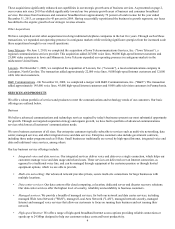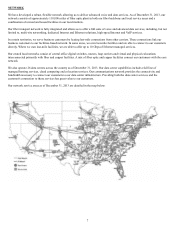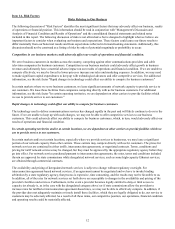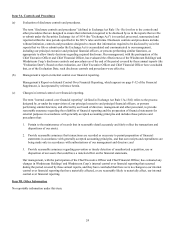Windstream 2013 Annual Report Download - page 112
Download and view the complete annual report
Please find page 112 of the 2013 Windstream annual report below. You can navigate through the pages in the report by either clicking on the pages listed below, or by using the keyword search tool below to find specific information within the annual report.14
We are subject to various forms of regulation from the Federal Communications Commission ("FCC") and state regulatory
commissions in the states in which we operate, which limit our pricing flexibility for regulated voice and high-speed Internet
products, subject us to service quality, service reporting and other obligations and expose us to the reduction of revenue
from changes to the universal service fund, the intercarrier compensation system, or access to interconnection with
competitors' facilities.
As of December 31, 2013, we had operating authority from each of the 48 states and the District of Columbia in which we
conducted local service operations, and we are subject to various forms of regulation from the regulatory commissions in each
of these areas as well as from the FCC. State regulatory commissions have jurisdiction over local and intrastate services
including, to some extent, the rates that we charge and service quality standards. The FCC has primary jurisdiction over
interstate services including the rates that we charge other telecommunications companies that use our network and other issues
related to interstate service. In some circumstances, these regulations restrict our ability to adjust rates to reflect market
conditions and may affect our ability to compete and respond to changing industry conditions.
Future revenues, costs, and capital investment in our wireline business could be adversely affected by material changes to or
decisions regarding applicability of government requirements, including, but not limited to, changes in rules governing
intercarrier compensation, state and federal USF support and other pricing and requirements. Federal and state communications
laws may be amended in the future, and other laws may affect our business. In addition, certain laws and regulations applicable
to us and our competitors may be, and have been, challenged in the courts and could be changed at any time. We cannot predict
future developments or changes to the regulatory environment or the impact such developments or changes would have.
In addition, these regulations could create significant compliance costs for us. Delays in obtaining certifications and regulatory
approvals could cause us to incur substantial legal and administrative expenses, and conditions imposed in connection with
such approvals could adversely affect the rates that we are able to charge our customers. Our business also may be affected by
legislation and regulation imposing new or greater obligations related to, for example, assisting law enforcement, bolstering
homeland and cyber-security, protecting intellectual property rights of third parties, minimizing environmental impacts,
protecting customer privacy, or addressing other issues that affect our business.
Our operations require substantial capital expenditures, and if funds for capital expenditures are not available when
needed, this could affect our service to customers and our growth opportunities.
We require substantial capital to maintain our network, and our growth strategy will require significant capital investments for
network enhancements and build-out. During 2013, we incurred $841.0 million in capital expenditures, and we expect to incur
in excess of $800 million in capital expenditures in 2014 due to our significant investments in fiber-to-the-tower and other
initiatives. See "Liquidity and Capital Resources" for our expected capital expenditures in 2014.
We use a significant portion of our cash generated from operations to pay dividends to stockholders, which could limit our
ability to make the capital expenditures necessary to support our business needs and growth plans. We expect to be able to fund
required capital expenditures from cash generated from operations. However, other risk factors described in this section could
materially reduce cash available from operations or significantly increase our capital expenditure requirements. If this occurs,
funds for capital expenditures may not be available when needed, which could affect our service to customers and our growth
opportunities.
We may need to defend ourselves against lawsuits or claims that we infringe upon the intellectual property rights of others.
From time to time, we receive notices from third parties, or we are named in lawsuits filed by third parties, claiming we have
infringed or are infringing upon their intellectual property rights. We may receive similar notices or be involved in similar
lawsuits in the future. In certain situations, we may have the ability to seek indemnification from our vendors regarding these
lawsuits or claims. If we cannot enforce our indemnification rights or if our vendors lack the financial means to indemnify us,
these claims may require us to expend significant time and money defending our alleged use of the affected technology, may
require us to enter into licensing agreements requiring one-time or periodic royalty payments that we would not otherwise have
to pay or may require us to pay damages. If we are required to take one or more of these actions, it may result in an adverse
impact to our results of operations and financial condition. In addition, in responding to these claims, we may be required to
stop selling or redesign one or more of our products or services, which could adversely affect the way we conduct our business.
























